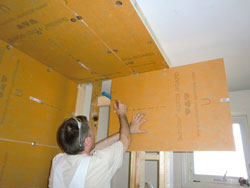 Every so often a building material hits the scene and changes everything. Something called KERDI-BOARD is one of them. It’s a rigid, waterproof, structural foam substrate for supporting tiles and it expands the possibilities for ceramic and porcelain tile installation more than anything else I’ve ever seen. I first learned about KERDI-BOARD ten years ago, and since then I’ve used it on a number of projects. It’s much easier to work with than cement board, and it works better than cement board as a tile substrate in many applications. Click here to learn how a non-professional built a great tiled bathroom using this material.
Every so often a building material hits the scene and changes everything. Something called KERDI-BOARD is one of them. It’s a rigid, waterproof, structural foam substrate for supporting tiles and it expands the possibilities for ceramic and porcelain tile installation more than anything else I’ve ever seen. I first learned about KERDI-BOARD ten years ago, and since then I’ve used it on a number of projects. It’s much easier to work with than cement board, and it works better than cement board as a tile substrate in many applications. Click here to learn how a non-professional built a great tiled bathroom using this material.
Want a tiled countertop? Glue KERDI-BOARD to the top of your cabinets (no plywood substrate needed in most cases), then apply tiles. How about a curved, tiled vanity? Cut pieces of KERDI-BOARD for the structure with a utility knife, then join them together with the same kind of thinset mortar used to secure tiles everywhere. Thinking of building a shower stall? Apply KERDI-BOARD to the existing walls of your house using stainless steel washers and screws made for the job, add a sloped shower base and joint-waterproofing fabric, then apply tiles and grout. Even a shower stall partition wall can be made of KERDI-BOARD alone – no wood framing necessary. The system includes metal channels for fastening the board to the wall, ceiling and floor, with stainless steel edge caps to create a finished edge on the partition.
Got an uneven block or masonry wall you want to tile? Trowel a coat of thinset tile mortar onto the rough surface, then nestle a sheet of KERDI-BOARD into place. The thinset mortar fills the various gaps underneath the board, creating a flat, smooth and waterproof surface for tiling. No need for mechanical anchoring.
I’m surprised and impressed with the things that KERDI-BOARD makes possible. That’s why I’m sure you’re going to see and hear about it as the product becomes more and more mainstream.